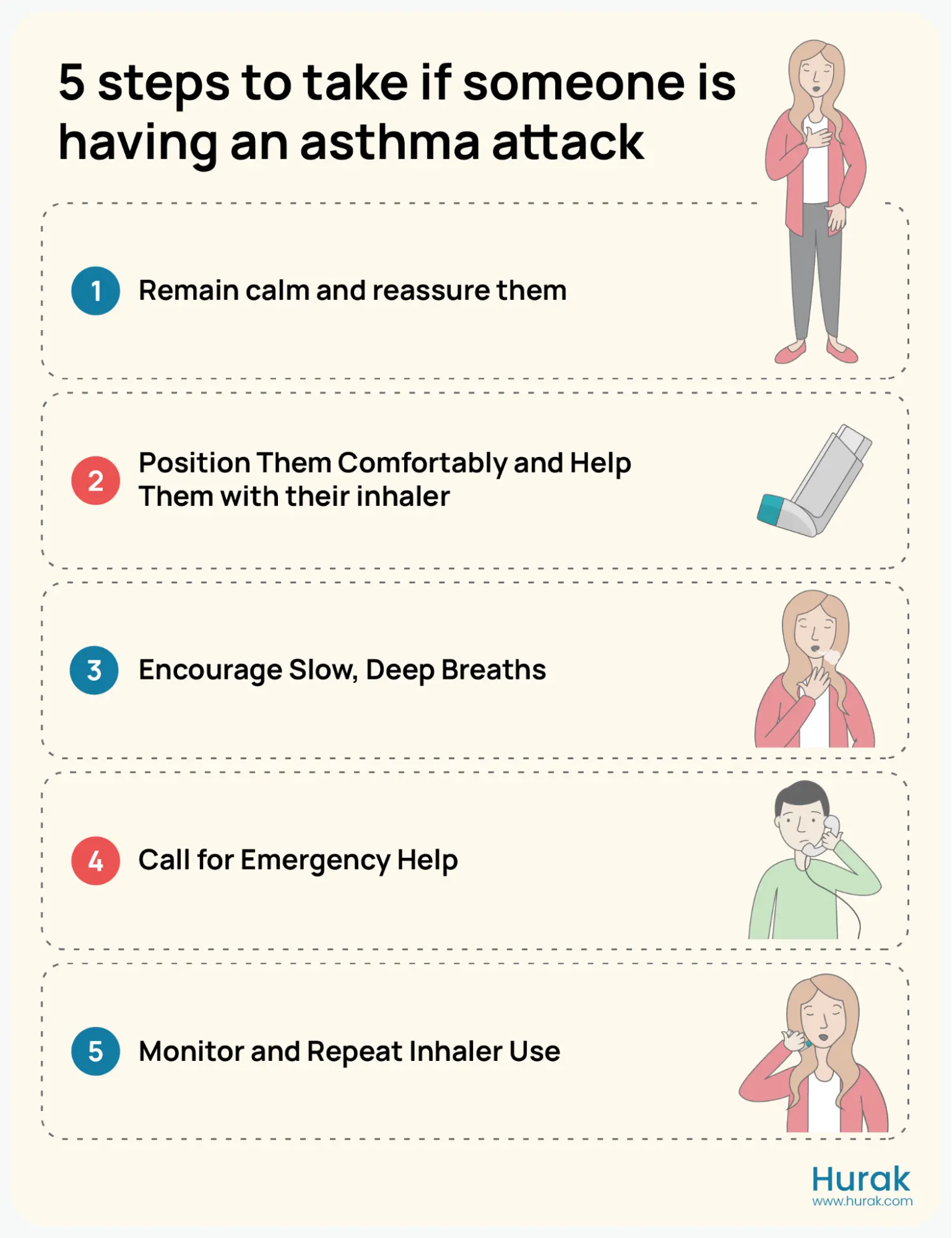There are several things you can do if you see someone having an asthma attack. Help them sit in a comfortable position and give them their inhaler. If they don’t have their inhaler, reassure them while you call the emergency helpline. Remind them to take slow and steady breaths, and if needed, help them repeat the use of the inhaler.
How to Use Your Inhaler During an Asthma Attack
Asthma attacks can be frightening for the individual experiencing them and those attending them. The approach to handling such a situation is timely and effective action, understanding how to provide asthma first aid with an inhaler is essential. It can help prevent serious consequences at home, work, or in public.
- Take 1 or 2 puffs of your reliever inhaler (usually blue) right away. If you have a spacer, use it. If taking 2 puffs, take them one at a time.
- Sit down and try to breathe slowly and steadily.
- If you don’t feel better, take 1 puff every minute. You can take up to 10 puffs. It’s easier with a spacer if you have one.
- If you’re still not feeling better or you’re worried, call 999.
- If the ambulance doesn’t arrive in 10 minutes and you still feel bad, repeat step 3.
- Your inhaler might be empty. Try another one if you have it to see if it helps.
If you feel better and don’t need to call 999, still see a doctor or asthma nurse within 24 hours.
Recognising the signs of an Asthma Attack.
An asthma attack occurs when the airways become inflamed, narrow and produce excess mucus, making breathing difficult.
Common signs include:
- Severe shortness of breath
- Wheezing or coughing
- Tightness in the chest
- Difficulty speaking in full sentences
- Anxiety or panic due to difficulty breathing
What are the causes and triggers of asthma attacks?
- Allergens: Pollen, dust mites, mold, pet dander, roach droppings
- Respiratory infections: Colds, flu, sinus infections, or viral infections
- Air pollution: Smoke, smog, fumes, strong perfumes, and chemical irritants
- Weather conditions: Cold air, hot and humid weather, or drastic temperature changes
- Physical activity: Overexerting with physical exercise, especially in cold or dry air
- Strong emotions: Stress, anxiety, or laughing intensely
- Smoking: Exposure to cigarette smoke, either active or passive can trigger an attack
- Medications: Medicines such as beta-blockers or non-steroidal anti-inflammatory drugs can sometimes be a trigger
- Food additives: Anything with sulfite, which commonly found in wine, dried fruits, or certain processed foods
- Gastroesophageal reflux disease (GERD): Acid reflux can trigger asthma symptoms
- Environmental factors: Exposure to strong chemicals, perfumes, or cleaning products
- Hormonal changes: For women menstruation or pregnancy can often be a cause or trigger an asthma attack.

5 steps to take if someone is having an asthma attack
If you encounter someone suffering from an asthma flare-up, also known as exacerbation, taking the following steps can help them.
- Remain calm and reassure them:
Stay calm and Reassure them that help is available. - Position Them Comfortably and Help Them with their inhaler:
Encourage them to use their reliever inhaler, which helps relax the airways. - Encourage Slow, Deep Breaths:
Guide them to take slow, steady breaths if they can. This helps reduce panic and allows more oxygen into their lungs. - Call for Emergency Help if:
The person is too breathless to speak.
Their lips or face turn blue.
They lose consciousness. - Monitor and Repeat Inhaler Use:
While waiting for help, the person can continue taking their reliever inhaler every few minutes as directed by their medical advisor.

Enrol in our comprehensive first aid course to gain the essential skills and confidently handle any emergency.
What Not to Do During an Asthma Attack
Don’t give them anything to eat or drink. This can increase the risk of choking.
Don’t leave them alone. Stay with them until they recover or help arrives.
Avoid forcing them to lie down. This can worsen their symptoms.
Preventing Future Asthma Attacks
After the situation stabilizes, it’s essential for the individual to consult their doctor about their asthma management plan.
This plan typically includes:
- Regular use of preventer inhalers.
- Avoiding known triggers.
- Keeping reliever inhalers readily available.
Final Thoughts
Knowing how to help someone during an asthma attack can save a life. You can improve their chances of recovery by staying calm, helping them sit in the correct position, and ensuring they take the proper medication to relieve their symptoms quickly. Swift action and proper asthma first aid are critical in such situations.




